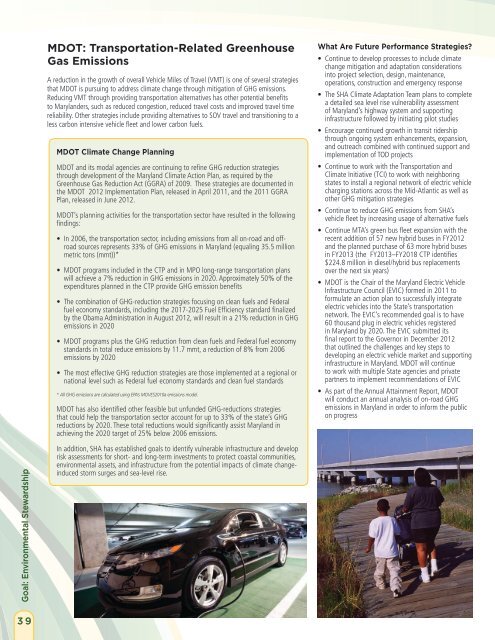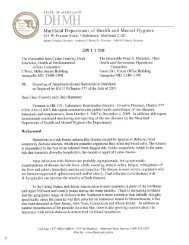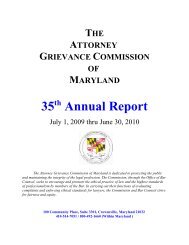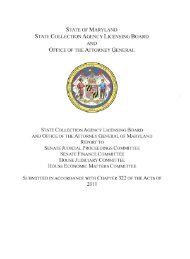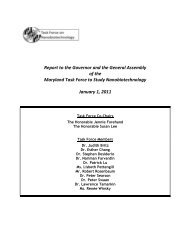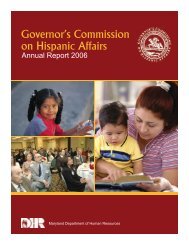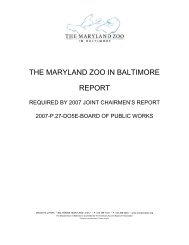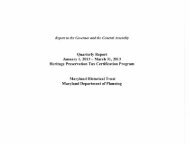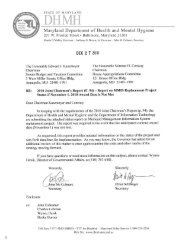2013 Attainment Report - Maryland Department of Transportation ...
2013 Attainment Report - Maryland Department of Transportation ...
2013 Attainment Report - Maryland Department of Transportation ...
- No tags were found...
You also want an ePaper? Increase the reach of your titles
YUMPU automatically turns print PDFs into web optimized ePapers that Google loves.
MDOT: <strong>Transportation</strong>-Related GreenhouseGas EmissionsA reduction in the growth <strong>of</strong> overall Vehicle Miles <strong>of</strong> Travel (VMT) is one <strong>of</strong> several strategiesthat MDOT is pursuing to address climate change through mitigation <strong>of</strong> GHG emissions.Reducing VMT through providing transportation alternatives has other potential benefitsto <strong>Maryland</strong>ers, such as reduced congestion, reduced travel costs and improved travel timereliability. Other strategies include providing alternatives to SOV travel and transitioning to aless carbon intensive vehicle fleet and lower carbon fuels.MDOT Climate Change PlanningMDOT and its modal agencies are continuing to refine GHG reduction strategiesthrough development <strong>of</strong> the <strong>Maryland</strong> Climate Action Plan, as required by theGreenhouse Gas Reduction Act (GGRA) <strong>of</strong> 2009. These strategies are documented inthe MDOT 2012 Implementation Plan, released in April 2011, and the 2011 GGRAPlan, released in June 2012.MDOT’s planning activities for the transportation sector have resulted in the followingfindings:• In 2006, the transportation sector, including emissions from all on-road and <strong>of</strong>froadsources represents 33% <strong>of</strong> GHG emissions in <strong>Maryland</strong> (equaling 35.5 millionmetric tons (mmt))*• MDOT programs included in the CTP and in MPO long-range transportation planswill achieve a 7% reduction in GHG emissions in 2020. Approximately 50% <strong>of</strong> theexpenditures planned in the CTP provide GHG emission benefits• The combination <strong>of</strong> GHG-reduction strategies focusing on clean fuels and Federalfuel economy standards, including the 2017-2025 Fuel Efficiency standard finalizedby the Obama Administration in August 2012, will result in a 21% reduction in GHGemissions in 2020• MDOT programs plus the GHG reduction from clean fuels and Federal fuel economystandards in total reduce emissions by 11.7 mmt, a reduction <strong>of</strong> 8% from 2006emissions by 2020• The most effective GHG reduction strategies are those implemented at a regional ornational level such as Federal fuel economy standards and clean fuel standards* All GHG emissions are calculated using EPA’s MOVES2010a emissions model.MDOT has also identified other feasible but unfunded GHG-reductions strategiesthat could help the transportation sector account for up to 33% <strong>of</strong> the state’s GHGreductions by 2020. These total reductions would significantly assist <strong>Maryland</strong> inachieving the 2020 target <strong>of</strong> 25% below 2006 emissions.What Are Future Performance Strategies?• Continue to develop processes to include climatechange mitigation and adaptation considerationsinto project selection, design, maintenance,operations, construction and emergency response• The SHA Climate Adaptation Team plans to completea detailed sea level rise vulnerability assessment<strong>of</strong> <strong>Maryland</strong>’s highway system and supportinginfrastructure followed by initiating pilot studies• Encourage continued growth in transit ridershipthrough ongoing system enhancements, expansion,and outreach combined with continued support andimplementation <strong>of</strong> TOD projects• Continue to work with the <strong>Transportation</strong> andClimate Initiative (TCI) to work with neighboringstates to install a regional network <strong>of</strong> electric vehiclecharging stations across the Mid-Atlantic as well asother GHG mitigation strategies• Continue to reduce GHG emissions from SHA’svehicle fleet by increasing usage <strong>of</strong> alternative fuels• Continue MTA’s green bus fleet expansion with therecent addition <strong>of</strong> 57 new hybrid buses in FY2012and the planned purchase <strong>of</strong> 63 more hybrid busesin FY<strong>2013</strong> (the FY<strong>2013</strong>–FY2018 CTP identifies$224.8 million in diesel/hybrid bus replacementsover the next six years)• MDOT is the Chair <strong>of</strong> the <strong>Maryland</strong> Electric VehicleInfrastructure Council (EVIC) formed in 2011 t<strong>of</strong>ormulate an action plan to successfully integrateelectric vehicles into the State’s transportationnetwork. The EVIC’s recommended goal is to have60 thousand plug in electric vehicles registeredin <strong>Maryland</strong> by 2020. The EVIC submitted itsfinal report to the Governor in December 2012that outlined the challenges and key steps todeveloping an electric vehicle market and supportinginfrastructure in <strong>Maryland</strong>. MDOT will continueto work with multiple State agencies and privatepartners to implement recommendations <strong>of</strong> EVIC• As part <strong>of</strong> the Annual <strong>Attainment</strong> <strong>Report</strong>, MDOTwill conduct an annual analysis <strong>of</strong> on-road GHGemissions in <strong>Maryland</strong> in order to inform the publicon progressGoal: Environmental StewardshipIn addition, SHA has established goals to identify vulnerable infrastructure and developrisk assessments for short- and long-term investments to protect coastal communities,environmental assets, and infrastructure from the potential impacts <strong>of</strong> climate changeinducedstorm surges and sea-level rise.39


